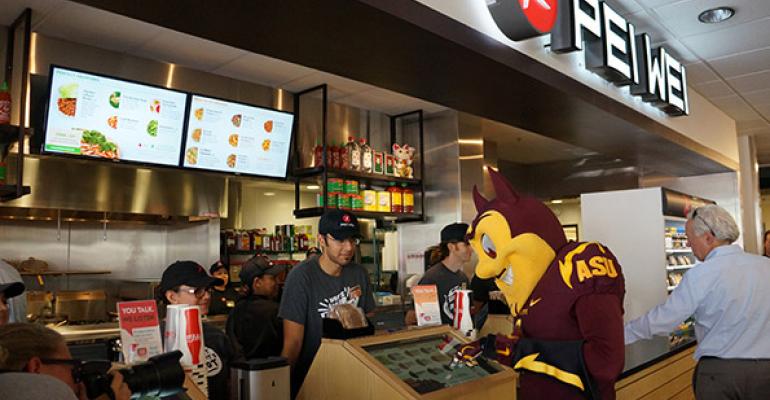Ralph Bower, who was named last year the first CEO of Pei Wei Asian Diner, has spent the past year developing plans for growth and overseeing the expansion of a reimaging program.
The 15-year-old Pei Wei chain, which was created in 2000 as a fast-casual offshoot of the casual-dining P.F. Chang’s China Bistro concept, is updating its menu and adding units, Bower said.
Bower joined Scottsdale, Ariz.-based Pei Wei in August 2014, after serving as president of Popeyes Louisana Kitchen Inc.’s U.S. division. Pei Wei has more than 200 locations in 24 states and is owned, along with P.F. Chang’s, by private-equity firm Centerbridge Partners LP under the corporate umbrella of Wok HoldCo LLC.
After opening Pei Wei’s 200th restaurant in Richardson, Texas, earlier this month, Bower discussed Thursday Pei Wei’s growth and the fast-casual Asian segment with Nation’s Restaurant News.
What have been the biggest changes in your year as CEO?
I think the biggest change has been ramping up our new-unit growth. We have 200 restaurants around the country, but in a lot of those places we don’t have the penetration that we have, say, in Dallas. We think in the next five years we can double in size without going into any new markets. There’s a lot of room in those markets for penetration.
How was growth in 2015?
This was a big growth year for us. We will have opened 12 restaurants by the end of the year. We will open 20-plus restaurants next year.
Pei Wei has been undergoing a reimaging campaign. Where does that stand now?
All of our new restaurants are in the new image. We’ve started to get some of our older restaurants into the new image. It will be at least a two-year process to convert them over. We’re getting good feedback from our guests and our team members, so we’re pretty excited.
What regions are seeing the renovations?
We’re rolling out the new image in the Texas and South Florida areas. It’s a lighter, brighter, fresher feel for our restaurants that really accentuates what we think is our brand differentiator, which is the quality of the food.
What are some of the elements of the re-imaging?
When you walk in, a lot of the artwork speaks to the fresh ingredients that we get into the house daily. The colors, where we used to use a lot of black and red, are now greens and things that we think sets Pei Wei apart from nearly every fast-casual competitor. Our back-of-house processes include having all of our meats cut by butchers who cut 10-pound pieces of flank into bite-sized pieces and slice and dice whole chicken breasts. … All of our vegetables come in the same way.
You introduced sushi about a year ago. How does that fit in?
Not only are we looking for a brighter, lighter, fresher feel in the environment, but on our menu as well. Sushi is the first step. Today it’s our highest-selling non-wok entrée. It actually outsells lettuce wraps now [a menu presentation borrowed from P.F. Chang’s China Bistro]. We have five rolls: a spicy tuna roll, a mango California roll, two crunch rolls and a Kung Pao roll that is a twist on our Kung Pao chicken. We have a lot more sushi innovation coming down the road in 2016 as well.
So you will grow your sushi offerings?
We’re going to continue to grow our sushi line. We think the way consumers are eating today that they are looking for a national brand that can do sushi they can trust.
How about food preparation preferences?
Pei Wei was a pioneer in customization. You can get your dishes fried or you can get them steamed. You can get noodles as a base or brown rice or white rice. And coming soon you’ll even be able to get salad as a base for any of our wok entrees.
How do the new units compare in size to older restaurants?
Our footprint is about 3,000 square feet and about 60 seats. That’s been where we’ve been for about the past decade or so. We’re one of the few fast-casual brands that has a bigger dinner [daypart] than lunch, so we need those seats. I’d actually like to see us get more seats so we can accommodate the capacity.
How have you seen takeout grow as a percentage of sales?
Take-out has increased every year. At Pei Wei, takeout makes up about 43 percent of our sales, up from 40 percent two years ago. I think that’s going to continue to grow. I want to see Pei Wei be a leader in takeout. A lot of families come to us as their home-meal replacement at dinnertime. We’re going to be introducing technology and ops procedures to make Pei Wei the easiest place for takeout in 2016.
How about delivery?
If you look across the country, about 60 percent of Asian food occasions occur off-premise. Right now, my point of view is that we’re a brand that’s differentiated by the quality of the food. I want to be very careful about delivery to make sure that we can guarantee that quality when the product gets delivered. We have to be confident from the quality standpoint before we put our name on it.
Contact Ron Ruggless at [email protected].
Follow him on Twitter: @RonRuggless





